Review: Spy vs Spy
Publisher: Milton Bradley
Year: 1986
Tagline: AN EXPLOSIVE TUNNEL-BUILDING GAME OF RISK AND RIVALRY!
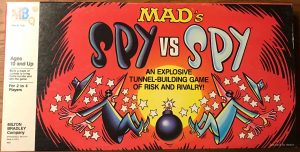
HOW WE MET
I found Spy vs. Spy at an Estate Sale in late summer of 2017. We were nowhere near the estate sale, but the photos indicated enough game interest for us to hop right over. We got there at the end of Day 1, which is right before 50% off day, but there was still a ton of stuff left. Bill found some crazy cheap vinyl and I found Spy vs. Spy and Clue Master Detective, for $5 each. While $5 is more than I like to pay for games I typically buy, these were a couple of rare birds and their condition was immaculate.
HOW IT PLAYS
Spy vs. Spy is a tile placement, pick up and deliver game. The object of the game is to bring home a certain number of bombs based on the number of players. For our 4-player game this was four bombs. Then you win!
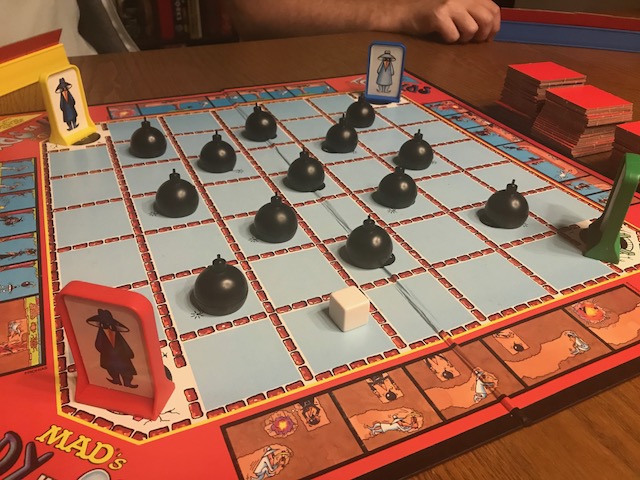
Players start the game on their respective manholes with four tiles, a spy pawn and a rack matching the color of their pawn. Tiles are mostly different tunnels but some are spies, without tunnels. You play TUNNEL TILEs to move around the board. You play spies on top of TUNNEL TILEs to block a tunnel, but there are some rules: white spies can only be played on TUNNEL TILEs with black spies, and vice versa. Grey spies can be played on either.
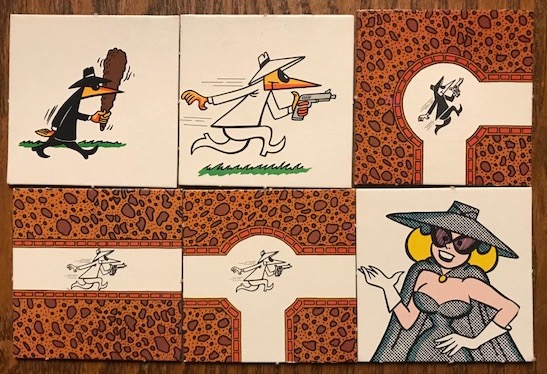
Your basic turn goes:
- Move your pawn to another tunnel tile (this assumes there is one in front of you already from a previous turn – if you can’t move, you can’t move)
- Roll the BOMB DIE if relevant
- Draw a tile and play one of your tiles
- Read the message under your bomb if you get a bomb home
Spies can not be played on top of another spy tile, under a bomb, under a pawn, on a manhole or on an already repaired tile. This means the tile pile in a given space can only get up to 3 (one tunnel, one spy / block and one tunnel / unblock), and no larger.
TUNNEL TILEs can only be played in legal ways, so you can’t place one if it leaves a tunnel to nowhere, even if it’s the only option. But the tunnels are used to move your pawn forward through the mess and try to capture bombs.
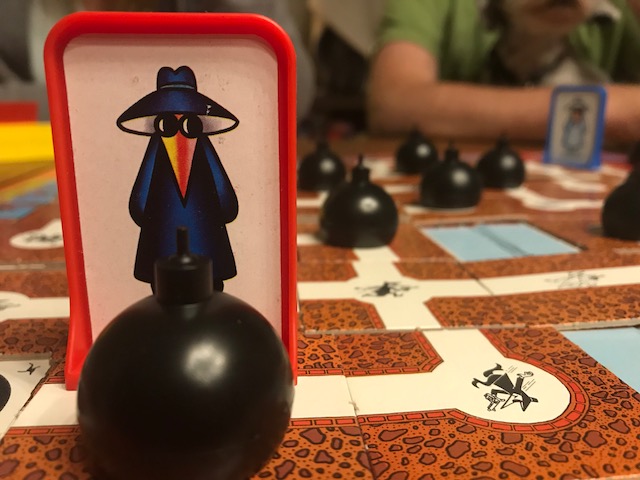
One thing you have going for you is that you can move as far as possible without turning a corner along a certain tunnel and still only make one movement. This becomes important later in the game, when you need to move quickly to try and capture bombs.
If you do reach a bomb, congratulations! You are partially there. The first thing you do is roll the BOMB DIE. This die has many blank sides and one side indicating an explosion. If you roll a blank you are good for now, and your turn ends. If you roll the explosion then you are moved back to your manhole and leave the bomb behind.
You have to make this same roll if you start your turn in the same space as a bomb. So if you find a bomb, great, but you have to pass the roll until the point you get the bomb home. That could be several turns, so don’t get too comfy. And you can only carry one bomb at a time, so don’t try to get all creative.
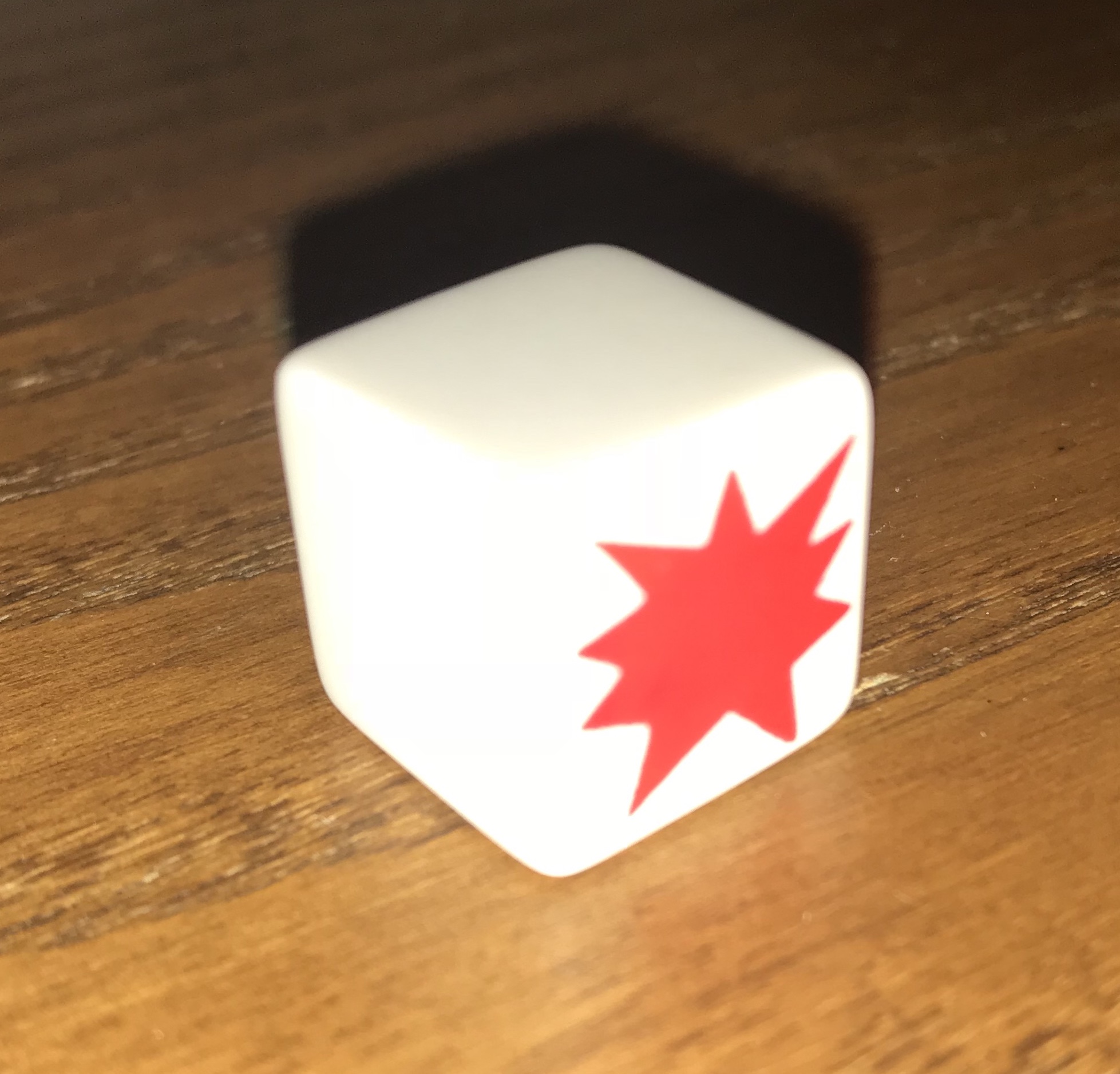
Instead of taking a regular turn you can choose to ditch your tiles. You can choose from one to four tiles to discard and draw new tiles. But this does replace any normal play during your turn.
If you manage to roll very well and get a bomb home then you get to read the bottom of it! Bombs offer different benefits, from taking another turn to drawing another tile. And if you get the number of bombs needed home, you win!
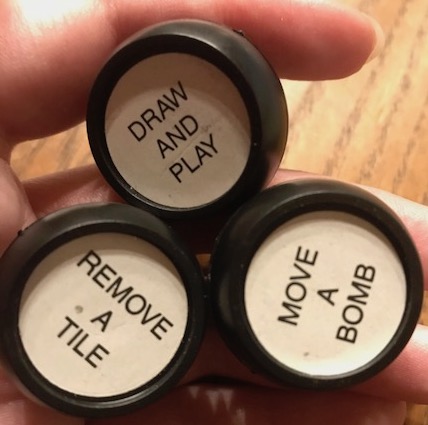
HOW IT WENT
Since we play a lot of vintage games, we end up playing a lot of electronic games and a LOT of roll and move. I appreciated that Spy vs. Spy brought something a little different to the table with tile laying. However, the underlying path to victory is the same as most vintage games – it is luck.
The luck of the draw is important. Do you have the right cards to tunnel to bombs efficiently? Do you have the right cards to unblock your blocked tunnels? The roll of the die is very important. Can you grab the bomb and drag it all the way back to your manhole without rolling the explosion? The bad luck of your opponents is important. Can you get to bombs before your opponents? The bottom of the bombs can be nice perks or just kind of nothing. Were you lucky enough to pick a good one?
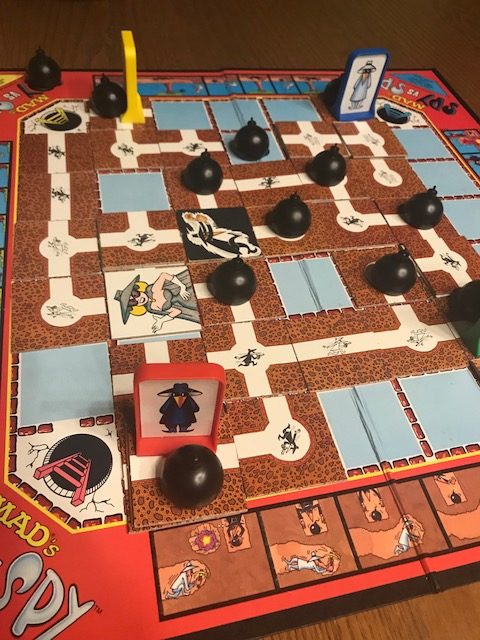
I think the translation of Spy vs. Spy to the game was pretty well done. There is plenty of “take that” going on, and instances where the white spy blocks the black spy and vice versa. Even though the pawns show you as either black or white spies, during play you do not necessarily identify strongly with one color or the other; tunnel blocks are based on the tunnel and not on your pawn. And your fellow color spy will likely block you just as enthusiastically as your opposite color spy.
The most memorable part of our play was that Bill has probably never rolled so poorly. He rolled the explosion a lot. Almost every time. He didn’t stand a chance.
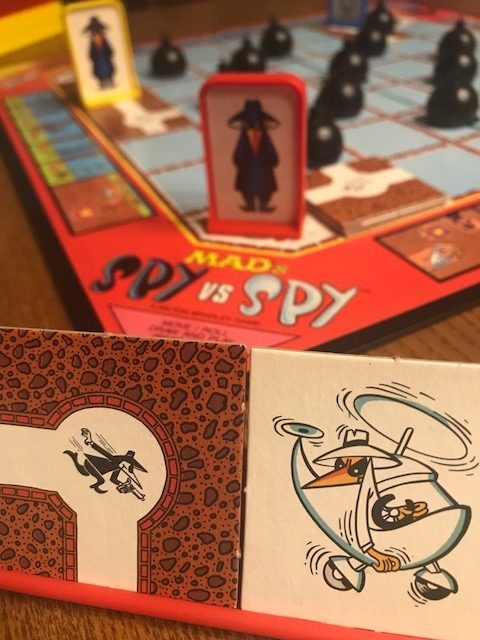
One warning that I would give you is not to use your block cards too early in the game. Once tunnels are joined and established, spies can really buzz around the board and it might be more critical for you to block your foes than it was early on. It might even be valuable to block your own paths so that you can fix the block with a more advantageous tile.
Our play went overly long and became extremely tedious. The beauty of this problem with this particular game is that it has a simple fix: collect fewer bombs than indicated in the instructions. The game would be much more enjoyable, maybe even tense, if we were only collecting two bombs. Three might be okay too. Four did not work well for us.
But I won, so..
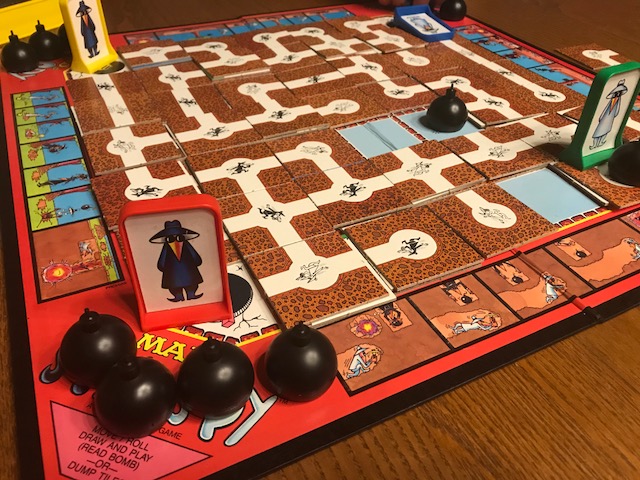
PLAY OR PASS
Play, but with the caveat mentioned above that you should adjust the rules to collect fewer bombs than indicated, at least for four players. Apart from gameplay dragging with more players, the game is lovely and a fun departure from typical vintage roll and move.